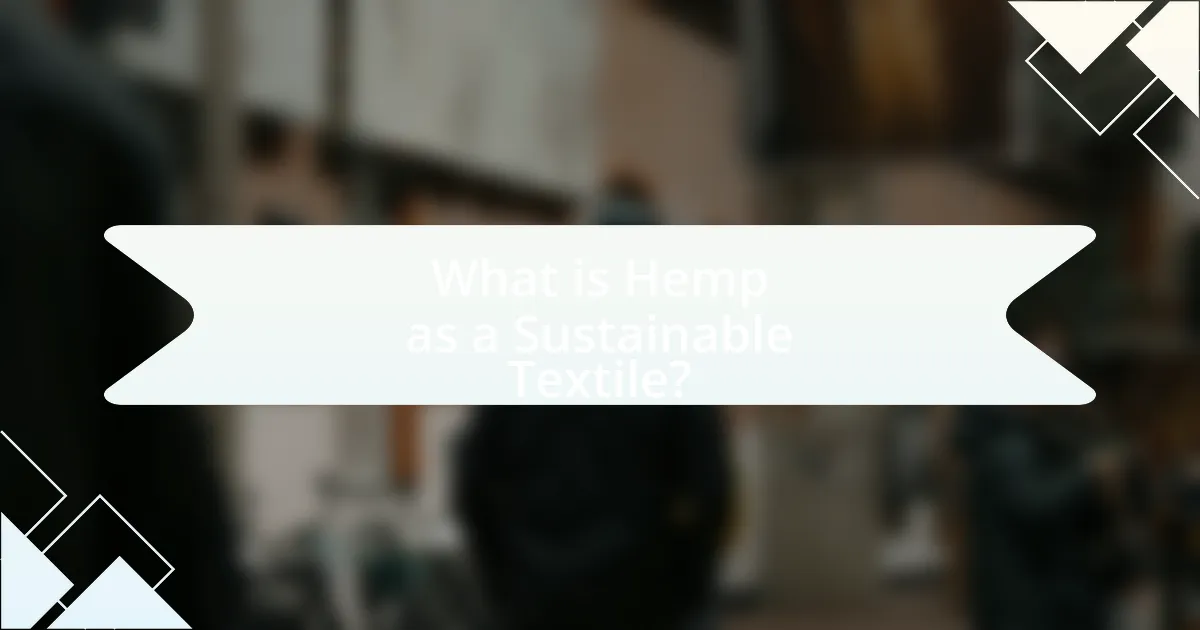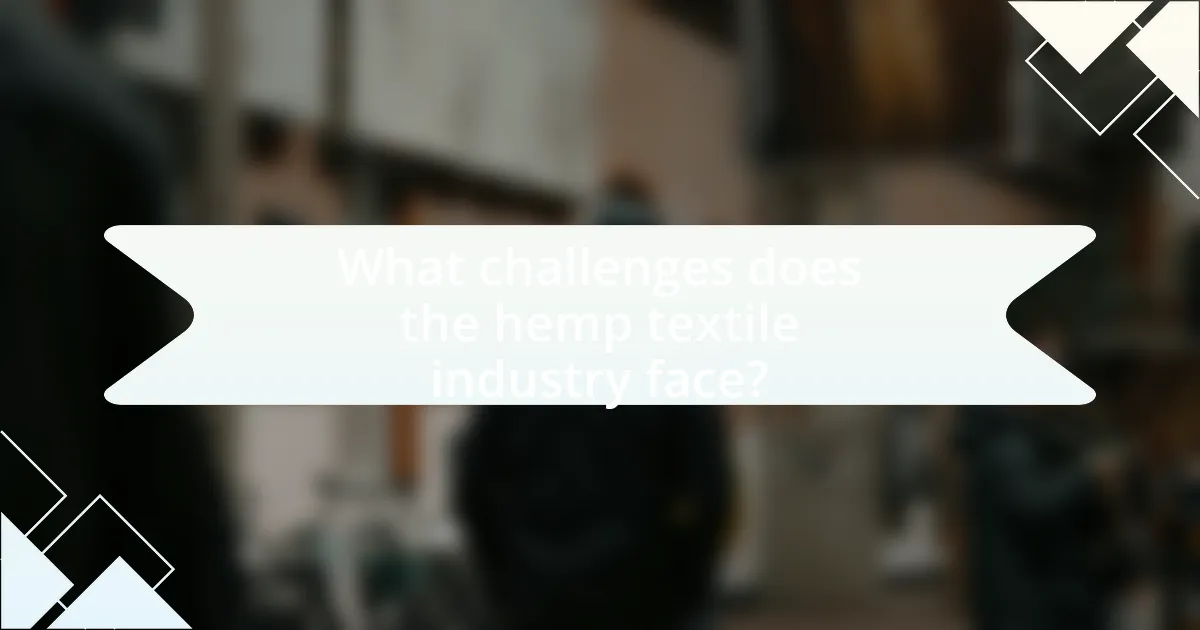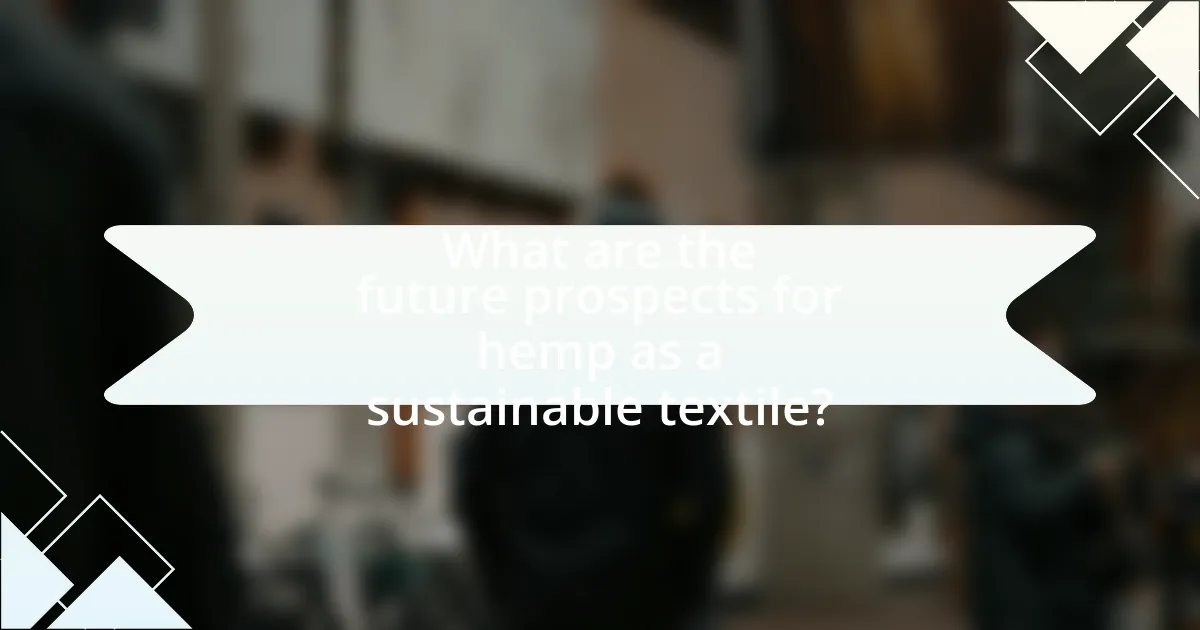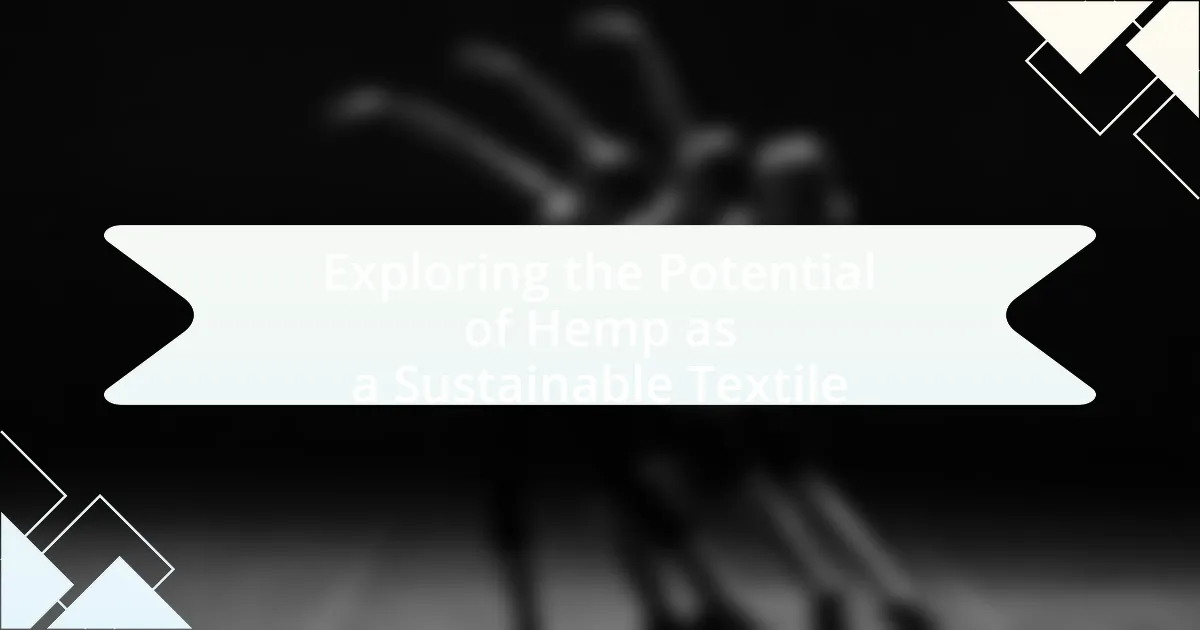Hemp, derived from the Cannabis sativa plant, is emerging as a sustainable textile known for its durability, breathability, and biodegradability. The article explores the cultivation process of hemp, highlighting its lower resource requirements compared to conventional crops like cotton, and its environmental benefits, including soil health improvement and carbon sequestration. It discusses the properties that make hemp suitable for textiles, its applications across various industries, and the challenges faced by the hemp textile market, such as regulatory hurdles and consumer misconceptions. Additionally, the article examines future prospects for hemp textiles, innovations in processing, and steps consumers can take to support this eco-friendly alternative in the fashion and textile industry.

What is Hemp as a Sustainable Textile?
Hemp is a sustainable textile derived from the fibers of the hemp plant, Cannabis sativa. This textile is known for its durability, breathability, and biodegradability, making it an eco-friendly alternative to conventional fabrics like cotton and polyester. Hemp cultivation requires significantly less water and pesticides compared to cotton, with studies indicating that it can produce up to four times more fiber per acre than cotton while using fewer resources. Additionally, hemp fibers are naturally resistant to mold and UV light, enhancing their longevity and reducing the need for chemical treatments.
How is hemp cultivated for textile production?
Hemp is cultivated for textile production through a process that involves selecting suitable varieties, preparing the soil, planting seeds, and managing growth. The cultivation begins with choosing fiber-specific hemp varieties, which are known for their long stalks and high fiber content. Farmers prepare the soil by ensuring it is well-drained and rich in nutrients, often using organic fertilizers to enhance growth.
Seeds are typically sown in spring, with a planting density of about 30 to 40 seeds per square meter to promote healthy growth. During the growing season, which lasts about 90 to 120 days, farmers manage the crop by controlling weeds and pests, often using sustainable practices to minimize chemical use. Harvesting occurs when the plants reach maturity, usually when the flowers have developed but before seed formation, to maximize fiber quality.
The harvested stalks are then processed through retting, which involves soaking them to separate the fibers from the woody core, followed by drying and mechanical processing to prepare the fibers for textile manufacturing. This method of cultivation and processing aligns with sustainable practices, as hemp requires less water and pesticides compared to conventional crops, making it an eco-friendly choice for textile production.
What are the environmental benefits of growing hemp?
Growing hemp offers significant environmental benefits, including soil health improvement, carbon sequestration, and reduced pesticide use. Hemp’s deep root system enhances soil structure and prevents erosion, while its rapid growth allows it to absorb carbon dioxide from the atmosphere, contributing to climate change mitigation. Additionally, hemp requires fewer pesticides and herbicides compared to traditional crops, promoting biodiversity and reducing chemical runoff into ecosystems. Studies indicate that hemp can sequester up to 15 tons of carbon dioxide per hectare annually, underscoring its potential as a sustainable agricultural choice.
How does the cultivation process differ from other fibers?
The cultivation process of hemp differs from other fibers primarily due to its rapid growth cycle and minimal resource requirements. Hemp can grow up to 15 feet in just 90 to 120 days, significantly faster than cotton, which typically takes several months to mature. Additionally, hemp requires less water and no pesticides, making it more environmentally sustainable compared to conventional fibers like cotton, which often relies heavily on chemical inputs and irrigation. This efficiency in growth and resource use positions hemp as a more sustainable option in the textile industry.
What properties make hemp suitable for textiles?
Hemp is suitable for textiles due to its strength, durability, breathability, and natural resistance to mold and UV light. The fibers of hemp are among the strongest of all natural fibers, making them ideal for producing long-lasting fabrics. Additionally, hemp textiles are breathable, allowing for moisture-wicking properties that enhance comfort. The natural resistance to mold and UV light contributes to the longevity of hemp fabrics, reducing the need for chemical treatments. These properties are supported by research indicating that hemp fibers can withstand wear and tear better than many other natural fibers, making them a sustainable choice for textiles.
How does hemp compare to cotton and synthetic fibers?
Hemp is more sustainable than cotton and synthetic fibers due to its lower environmental impact and superior durability. Unlike cotton, which requires significant water and pesticide use, hemp grows quickly with minimal resources, needing only about half the water of cotton and no harmful chemicals. Additionally, hemp fibers are stronger and more resistant to mold and UV light compared to both cotton and synthetic fibers, leading to longer-lasting products. Research indicates that hemp cultivation can improve soil health and reduce carbon emissions, making it a more eco-friendly option in the textile industry.
What are the durability and comfort characteristics of hemp textiles?
Hemp textiles are known for their exceptional durability and comfort. The durability of hemp fibers is attributed to their strong structure, which is significantly more robust than cotton, making them resistant to wear and tear. Studies indicate that hemp can withstand multiple wash cycles without losing its integrity, with some estimates suggesting a lifespan that can exceed that of conventional fabrics by several years.
In terms of comfort, hemp textiles are breathable and moisture-wicking, which enhances their wearability in various climates. The natural fibers allow for good air circulation, helping to regulate body temperature and reduce perspiration. Additionally, hemp textiles become softer with each wash, improving comfort over time. These characteristics make hemp a practical choice for sustainable fashion and textiles.
What are the potential applications of hemp textiles?
Hemp textiles have several potential applications, including clothing, home furnishings, industrial products, and eco-friendly packaging. In clothing, hemp is valued for its durability, breathability, and natural resistance to mold and UV light, making it suitable for garments like shirts, pants, and activewear. For home furnishings, hemp can be used in upholstery, curtains, and rugs due to its strength and aesthetic appeal. In industrial applications, hemp textiles are utilized in products such as ropes, sails, and insulation materials, benefiting from their tensile strength and biodegradability. Additionally, hemp fibers can be processed into biodegradable packaging materials, offering a sustainable alternative to plastic. These applications highlight hemp’s versatility and sustainability in various sectors.
In which industries can hemp textiles be utilized?
Hemp textiles can be utilized in various industries, including fashion, home furnishings, automotive, and construction. In the fashion industry, hemp is valued for its durability and eco-friendliness, making it suitable for clothing and accessories. The home furnishings sector uses hemp for upholstery, curtains, and bedding due to its strength and natural resistance to mold and pests. In the automotive industry, hemp composites are employed for interior panels and insulation, contributing to lightweight and sustainable vehicle designs. Additionally, the construction industry utilizes hemp in insulation materials and biocomposites, promoting energy efficiency and sustainability in building practices.
How can hemp textiles contribute to sustainable fashion?
Hemp textiles contribute to sustainable fashion by offering an eco-friendly alternative to conventional fabrics. Hemp requires significantly less water and no pesticides for cultivation, making it a more sustainable crop; for instance, it can grow in diverse climates and enrich soil health through crop rotation. Additionally, hemp fibers are biodegradable, reducing environmental impact at the end of their lifecycle. Studies indicate that hemp can produce up to four times more fiber per acre than cotton, highlighting its efficiency as a resource. This combination of low environmental impact and high yield positions hemp textiles as a viable solution for promoting sustainability in the fashion industry.

What challenges does the hemp textile industry face?
The hemp textile industry faces several significant challenges, including regulatory hurdles, limited processing infrastructure, and competition from synthetic fibers. Regulatory hurdles arise from varying legal statuses of hemp across different regions, which can hinder cultivation and production. Limited processing infrastructure restricts the ability to efficiently convert raw hemp into usable textiles, as many facilities are outdated or non-existent. Additionally, competition from cheaper synthetic fibers, such as polyester, poses a financial challenge, as consumers often prioritize cost over sustainability. These factors collectively impede the growth and adoption of hemp textiles in the market.
What are the regulatory hurdles for hemp production?
The regulatory hurdles for hemp production include federal and state licensing requirements, restrictions on THC levels, and compliance with agricultural regulations. In the United States, the 2018 Farm Bill legalized hemp but mandated that it must contain less than 0.3% THC, creating challenges for farmers in testing and compliance. Additionally, each state has its own regulations regarding hemp cultivation, which can vary significantly, leading to confusion and potential legal issues for producers. Furthermore, the lack of established infrastructure for processing and distribution adds another layer of complexity to the regulatory landscape.
How do legal restrictions impact the growth of the hemp textile market?
Legal restrictions significantly hinder the growth of the hemp textile market by limiting cultivation, processing, and distribution. In many regions, stringent regulations classify hemp similarly to marijuana, creating barriers for farmers and manufacturers. For instance, in the United States, the 2018 Farm Bill legalized hemp but left state-level regulations intact, resulting in a patchwork of laws that complicate market entry. This legal ambiguity can deter investment and innovation in hemp textiles, as companies face uncertainty regarding compliance and market access. Consequently, the restrictive legal environment stifles the potential for hemp to emerge as a sustainable alternative in the textile industry.
What are the challenges in processing hemp for textiles?
Processing hemp for textiles presents several challenges, including fiber extraction difficulties, variability in fiber quality, and limited processing infrastructure. The extraction process, known as retting, can be labor-intensive and requires precise conditions to separate the fibers from the stalks effectively. Additionally, the quality of hemp fibers can vary significantly based on growth conditions, which complicates standardization for textile production. Furthermore, the existing processing infrastructure is often inadequate, as many facilities are not equipped to handle hemp specifically, leading to inefficiencies and increased costs. These challenges hinder the widespread adoption of hemp in the textile industry despite its sustainability benefits.
How does consumer perception affect the hemp textile market?
Consumer perception significantly influences the hemp textile market by shaping demand and acceptance of hemp-based products. Positive perceptions regarding sustainability, eco-friendliness, and health benefits associated with hemp can lead to increased consumer interest and purchasing behavior. For instance, a survey conducted by the Hemp Industries Association in 2021 indicated that 70% of consumers prefer sustainable materials, which directly correlates with the rising popularity of hemp textiles. Conversely, negative perceptions, such as associations with cannabis or lack of awareness about hemp’s benefits, can hinder market growth. Therefore, consumer attitudes play a crucial role in determining the success and expansion of the hemp textile industry.
What misconceptions exist about hemp textiles?
Hemp textiles are often misunderstood, with common misconceptions including the belief that they are rough and uncomfortable. In reality, hemp fibers can be processed to create soft, breathable fabrics comparable to cotton. Another misconception is that hemp textiles are not durable; however, hemp is one of the strongest natural fibers, with a tensile strength greater than that of cotton and linen. Additionally, some people mistakenly think that hemp textiles are associated with illegal cannabis products, despite the fact that industrial hemp contains negligible levels of THC, the psychoactive compound. These misconceptions can hinder the acceptance and use of hemp as a sustainable textile option.
How can education improve consumer acceptance of hemp products?
Education can improve consumer acceptance of hemp products by increasing awareness of their benefits and dispelling misconceptions. By providing accurate information about hemp’s sustainability, health benefits, and versatility, educational initiatives can help consumers understand its positive environmental impact compared to conventional textiles. For instance, hemp requires less water and pesticides, making it a more eco-friendly option. Studies have shown that informed consumers are more likely to choose sustainable products; a survey by the Nielsen Global Sustainability Report indicated that 66% of consumers are willing to pay more for sustainable brands. Therefore, targeted educational campaigns can effectively enhance consumer trust and acceptance of hemp products in the textile industry.

What are the future prospects for hemp as a sustainable textile?
The future prospects for hemp as a sustainable textile are promising due to its eco-friendly properties and increasing demand for sustainable materials. Hemp requires significantly less water and pesticides compared to conventional cotton, making it a more sustainable option for textile production. Additionally, the global market for sustainable textiles is projected to grow, with a report by Grand View Research estimating it will reach $8.25 billion by 2025, indicating a favorable environment for hemp-based products. As consumers become more environmentally conscious, the shift towards sustainable textiles, including hemp, is likely to accelerate, further enhancing its market viability.
How can technology enhance hemp textile production?
Technology can enhance hemp textile production by improving processing efficiency and product quality. Advanced machinery, such as automated decorticators, can streamline the separation of hemp fibers from the stalk, significantly reducing labor costs and time. Additionally, innovations in biotechnology, like enzyme treatments, can enhance fiber strength and softness, making hemp textiles more competitive with conventional fabrics. For instance, a study published in the Journal of Cleaner Production found that using enzymatic processes can increase the tensile strength of hemp fibers by up to 30%. These technological advancements not only optimize production but also contribute to the sustainability of hemp textiles by minimizing waste and energy consumption.
What innovations are being developed in hemp processing?
Innovations in hemp processing include advancements in decortication technology, which enhances fiber extraction efficiency, and the development of enzymatic treatments that improve fiber quality. For instance, companies are utilizing mechanical and chemical methods to streamline the separation of hemp fibers from the stalk, resulting in higher yields and lower production costs. Additionally, research is focusing on bio-based processing techniques that reduce environmental impact, such as using natural enzymes to break down hemp cellulose, which can lead to more sustainable textile production. These innovations are supported by studies indicating that improved processing methods can significantly increase the economic viability of hemp as a sustainable textile option.
How can sustainable practices be integrated into hemp textile manufacturing?
Sustainable practices can be integrated into hemp textile manufacturing by utilizing organic farming methods, implementing water-efficient processing techniques, and promoting circular economy principles. Organic farming reduces chemical inputs, enhancing soil health and biodiversity, while water-efficient techniques, such as closed-loop systems, minimize water usage and pollution. Additionally, adopting circular economy principles, like recycling and upcycling hemp textiles, reduces waste and extends product life cycles. These practices are supported by studies indicating that hemp requires significantly less water than cotton and can be grown without synthetic pesticides, making it a more sustainable option for textile production.
What steps can consumers take to support hemp textiles?
Consumers can support hemp textiles by choosing products made from hemp, advocating for sustainable practices, and educating themselves and others about the benefits of hemp. By purchasing hemp clothing and home goods, consumers directly contribute to the demand for hemp, which can lead to increased production and innovation in the industry. Advocacy for policies that promote hemp farming and textile production can further enhance the market. Additionally, educating oneself about the environmental benefits of hemp, such as its lower water usage and reduced pesticide needs compared to conventional cotton, empowers consumers to make informed choices and spread awareness, thereby fostering a more sustainable textile industry.
How can consumers identify and choose hemp textile products?
Consumers can identify and choose hemp textile products by looking for specific labels and certifications that indicate the material’s authenticity and sustainability. For instance, products labeled as “100% hemp” or “hemp blend” ensure that the textiles contain genuine hemp fibers. Additionally, certifications such as Global Organic Textile Standard (GOTS) or OEKO-TEX Standard 100 provide assurance that the textiles meet environmental and safety criteria. Research shows that hemp requires less water and pesticides compared to conventional cotton, making it a more sustainable choice. Therefore, consumers should prioritize these labels and certifications to make informed decisions about hemp textile products.
What are the best practices for caring for hemp textiles?
The best practices for caring for hemp textiles include washing in cold water, using mild detergents, and air drying to maintain the fabric’s integrity. Cold water prevents shrinkage and color fading, while mild detergents avoid harsh chemicals that can degrade the fibers. Air drying helps preserve the natural texture and strength of hemp, as high heat from dryers can weaken the material. Additionally, it is advisable to avoid bleach and fabric softeners, as these can damage the fibers and reduce the lifespan of the textile. Regularly rotating and gently brushing hemp items can also help maintain their appearance and durability.

Leave a Reply